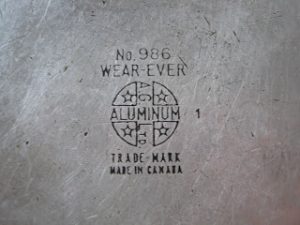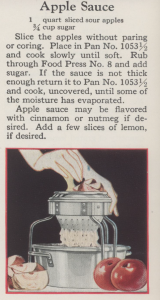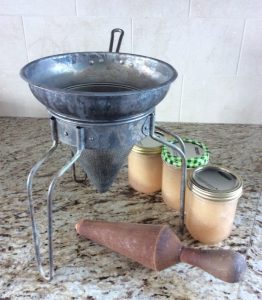Wear-Ever pots and utensils have played an important role in North American cuisine, and one unexpected way is in the making of applesauce. A few years ago I was visiting a friend and she was making applesauce to preserve for her grandchildren. “So much work,” she complained, “all that peeling and coring.” I said to her that I probably would never make applesauce if I had to do all that work and I explained to her how I make applesauce the way my mother (and probably a lot of women in North America) did who bought Wear-Ever pots and utensils.
These aluminum products were marketed by door-to-door salesmen across Canada and the United States, although in Canada they could also be purchased from Eaton’s catalogue[i]. By the 1940’s Wear-Ever accounted for more than 40 percent of the aluminum cookware business in the United States. I imagine it was about this time that my mother bought the Ever-Wear cooking utensils that were in our home until a fire destroyed much of it.
First produced in 1825, aluminum was prohibitively expensive to produce and was therefore classed as a semi-precious metal. On February 23, 1886, while working in a woodshed in his kitchen in Oberlin, Ohio, Charles Hall discovered an inexpensive method of smelting aluminum out of bauxite and founded the Pittsburgh Reduction Company in 1888, which became the Aluminum Company of America (ALCOA) in 1907. As a way to increase the market for this new material, Wear-Ever cookware was launched in 1903. The marketing slogan was “Replace utensils that wear out with utensils that Wear-Ever!”) [ii]
Wear-Ever products in Canada were made by the Northern Aluminum Company, founded in Shawinigan, Quebec in 1902. (In 1925, it became the Aluminum Company of Canada, better known as Alcan). In 1913, the company opened a kitchen utensil plant and foundry in Toronto, and a rolling mill a few years later. You could identify the ones made in Canada by this trade-mark.[iii]
In the 1930s Jack Luck, an immigrant from London, joined the Alcan subsidiary Aluminum Goods in Toronto. As a draftsman in the engineering department he designed many award-wing pots and pans, kettles, coffee makers, and even door pulls under the Wear-Ever brand. [iv]
Wear-Ever products were marketed as “the new method of cooking”. A US pamphlet circa 1930 titled Wear-Ever Aluminum Specialties states, “The purpose of the “Wear-Ever” New Method of Cooking is to cook foods without loss of natural flavors and valuable mineral elements”[v]. The emphasis was on “water-less” cooking as a way to retain the nutritional value of the food. The Wear-Ever cookbook shown here says “A large part of the mineral contained in vegetables and fruits lies directly beneath the skins. Avoid peeling these foods whenever possible”.
Wear-Ever products range from pots and pans to coffee makers to juicers and strainers. The Wear-Ever piece of equiment I use for making applesauce is called a food press in the Wear-Ever 1928 cookbook above [vi] and it is also referred to as a chinois. This is how making applesauce is explained on page 20:
I basically follow this method but I will sometimes add a small amount of water to the pot to prevent scorching on the bottom. Once you put the apples through the food press only the peels and bits of core are left, so there is little waste and a lot less effort.
Here is my mother’s Food Press No. 8 with the applesauce I prepared in it to be preserved this year. It has been well used and even survived the house fire!
[i] Image from the Fall and Winter 1948-49 Eaton’s Catalogue. Source: http://www.collectionscanada.gc.ca/obj/029006/f2/nlc003958.547.pdf
[ii] Source: http://progress-is-fine.blogspot.ca/2015/10/we-used-to-make-things-in-this-country_18.html
[iii] Source: http://gaddingaboutwithgrandpat.blogspot.ca/2011/08/among-my-fav-o-rite-things-vintage.htm
[iv] Theodoresu, I. (n.d.) Fancy Kitchen in Canada: A report on 20th century industrial design for domestic appliances. Retrieved from: https://documents.techno-science.ca/…/Teodorescu_FancyKitcheninCanadafinal.doc
[v] Source: The University of North Carolina at Greensboro
http://libcdm1.uncg.edu/cdm/ref/collection/HENP/id/705
[vi]Source:https://archive.lib.msu.edu/DMC/sliker/msuspcsbs_weae_aluminumco4/msuspc_weae_aluminumco4.pdf




